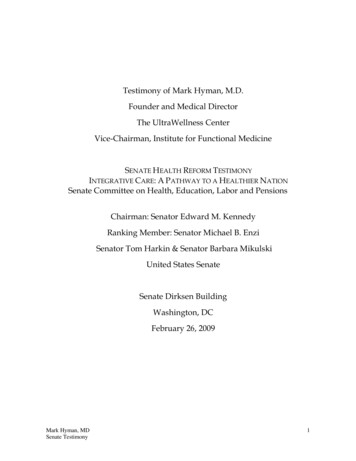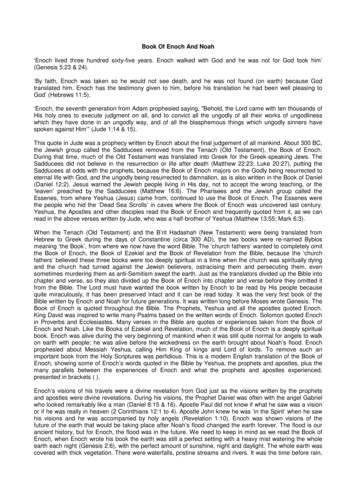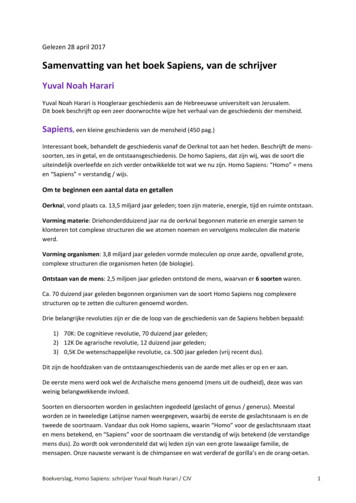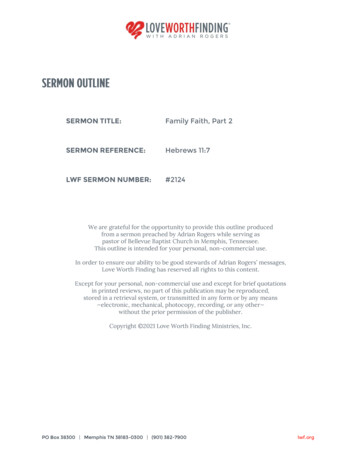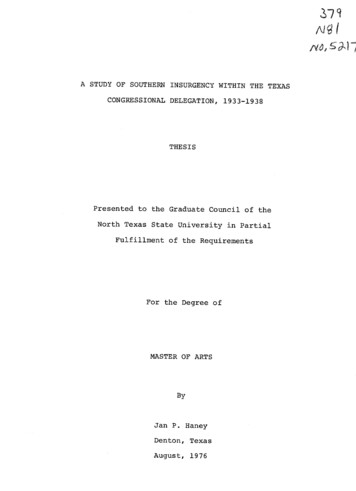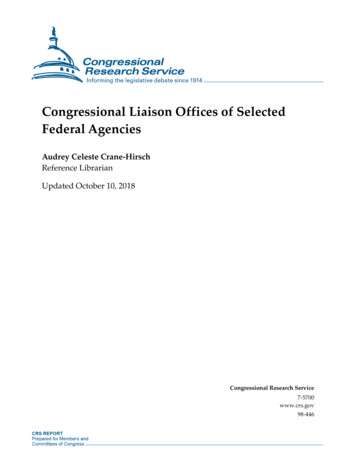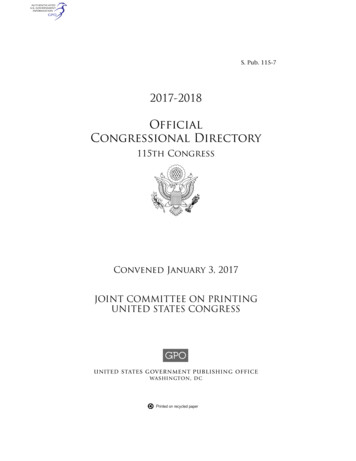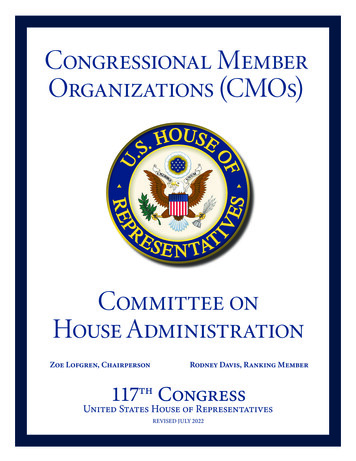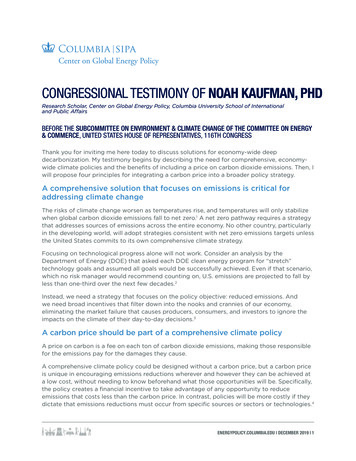
Transcription
CONGRESSIONAL TESTIMONY OF NOAH KAUFMAN, PHDResearch Scholar, Center on Global Energy Policy, Columbia University School of Internationaland Public AffairsBEFORE THE SUBCOMMITTEE ON ENVIRONMENT & CLIMATE CHANGE OF THE COMMITTEE ON ENERGY& COMMERCE, UNITED STATES HOUSE OF REPRESENTATIVES, 116TH CONGRESSThank you for inviting me here today to discuss solutions for economy-wide deepdecarbonization. My testimony begins by describing the need for comprehensive, economywide climate policies and the benefits of including a price on carbon dioxide emissions. Then, Iwill propose four principles for integrating a carbon price into a broader policy strategy.A comprehensive solution that focuses on emissions is critical foraddressing climate changeThe risks of climate change worsen as temperatures rise, and temperatures will only stabilizewhen global carbon dioxide emissions fall to net zero.1 A net zero pathway requires a strategythat addresses sources of emissions across the entire economy. No other country, particularlyin the developing world, will adopt strategies consistent with net zero emissions targets unlessthe United States commits to its own comprehensive climate strategy.Focusing on technological progress alone will not work. Consider an analysis by theDepartment of Energy (DOE) that asked each DOE clean energy program for “stretch”technology goals and assumed all goals would be successfully achieved. Even if that scenario,which no risk manager would recommend counting on, U.S. emissions are projected to fall byless than one-third over the next few decades.2Instead, we need a strategy that focuses on the policy objective: reduced emissions. Andwe need broad incentives that filter down into the nooks and crannies of our economy,eliminating the market failure that causes producers, consumers, and investors to ignore theimpacts on the climate of their day-to-day decisions.3A carbon price should be part of a comprehensive climate policyA price on carbon is a fee on each ton of carbon dioxide emissions, making those responsiblefor the emissions pay for the damages they cause.A comprehensive climate policy could be designed without a carbon price, but a carbon priceis unique in encouraging emissions reductions wherever and however they can be achieved ata low cost, without needing to know beforehand what those opportunities will be. Specifically,the policy creates a financial incentive to take advantage of any opportunity to reduceemissions that costs less than the carbon price. In contrast, policies will be more costly if theydictate that emissions reductions must occur from specific sources or sectors or technologies.4ENERGYPOLICY.COLUMBIA.EDU DECEMBER 2019 1
CONGRESSIONAL TESTIMONY OF NOAH KAUFMANThat is a key reason why a federal carbon price would achieve large emissions reductions ata small cost. Analysis led by the Center on Global Energy Policy at Columbia University findsthat a slowly rising carbon price starting at 50 per metric ton could cause net emissions tofall to 39-46 percent below 2005 levels in the first decade.5 That is the impact of the carbonprice by itself—far greater reductions could be achieved as part of a broader strategy andover a longer time horizon.Further, the analysis shows that the differences in U.S. gross domestic product betweenscenarios with and without a carbon price are well under 1 percent (see Figure 1).6 Thesestudies are of course imperfect—for example, they ignore the economic benefits of avoidedregulations and the innovation stimulated by the carbon price—nevertheless, given the largeemissions reductions the carbon price would achieve, it is notable that studies suggestroughly zero impacts on the overall growth of the U.S. economy.7Minimizing the costs of emissions reductions is not only beneficial to top-line indicators likeeconomic growth, but also means a lower economic burden on everyone, and these lowercosts should enable a more rapid pace of emissions reductions. For any policymaker withthe goals of deep decarbonization and a strong economy, putting a price on carbon dioxideemissions is a no brainer.Figure 1: Impacts of a Federal US Carbon Price on Emissions and Gross Domestic ProductNotes: The analysis examined three scenarios with carbon taxes starting in 2020, as well as the currentpolicy scenario for comparison. In the a 14/ton scenario, the tax starts at 14 per metric ton (in 2016dollars) and rises by about 3 percent annually (above inflation); in the 50/ton scenario: the tax starts at 50 per metric ton and rises by about 2 percent annually; in the 73/ton scenario, the tax starts at 73 permetric ton and rises by about 1.5 percent annually. The emissions analysis was conducted by the RhodiumGroup, and the economic analysis was conducted by Rice University’s Baker Institute.Source: Kaufman N. & Gordon K. “The Energy, Economic & Emissions Impacts of a Federal US Carbon Tax.”Columbia University Center on Global Energy Policy. July 2018.2 ENERGYPOLICY.COLUMBIA.EDU DECEMBER 2019
CONGRESSIONAL TESTIMONY OF NOAH KAUFMANIntegrating a carbon price into broader policy strategyThe decision to include a carbon price in a comprehensive climate policy strategy should beeasy,8 but how a carbon price is integrated into a broader policy strategy will influence itseffectiveness and its acceptability to the American people. In what follows, I will offer four policyprinciples that address valid concerns with economywide climate solutions:#1. Protect those who cannot afford price increasesAmericans who have trouble paying energy bills or maintaining adequate heating or coolingservices cannot afford to pay more. With a well-designed carbon price, they do not have to.The payments of the carbon price become government revenue. The most straightforwardway to protect those who cannot afford price increases is to use the revenue to providecompensation for the increase in expenditures caused by the carbon price: such payments areoften called “carbon dividends.”As a general rule-of-thumb, using ten percent of the revenue from the carbon price for carbondividends to households in the bottom twenty percent of the income distribution ensures thecarbon dividend payments to these households are larger than the payments of the carbonprice from these households.9Some policymakers will prefer to provide larger payments to low-income households, toensure that even outlier households are protected. Others will prefer to protect middleclass households as well. These goals can be readily achieved by using more than 10 percentof the revenue for carbon dividends. For example, one recent proposal in the House ofRepresentatives and Senate would use over half of the carbon pricing revenue to pay amonthly carbon dividend to households with annual incomes below 150,000.10 Anotherproposal, which has more than 70 cosponsors in the House of Representatives, uses nearly allrevenues for carbon dividend payments to all Americans, which creates a highly progressivepolicy (see Figure 2).11ENERGYPOLICY.COLUMBIA.EDU DECEMBER 2019 3
CONGRESSIONAL TESTIMONY OF NOAH KAUFMANFigure 2: Change in Tax Burden as a Percent of Pre-Tax Income in 2025 for a 50/Ton CarbonTax ScenarioNotes: Assumes a carbon tax of 50 per metric ton (in 2016 dollars) is implemented in 2020 and increasesby 2 percent annually (above inflation). Each bar in the figure reflects a different assumption about how100 percent of the carbon tax is used. The “per capita household rebate” scenario assumes all revenuesare used for carbon dividends. The analysis was conducted by the Urban-Brookings Tax Policy Center.Source: Kaufman N. & Gordon K. “The Energy, Economic & Emissions Impacts of a Federal US Carbon Tax.”Columbia University Center on Global Energy Policy. July 2018.Time and again, we see people around the world respond with outrage when energy pricesare raised in ways perceived as unfair.12 Notably, a recent national election in Canada sawabout two-thirds of the country vote for parties that support the national carbon pricingpolicy that includes protections for low- and middle-income households.13A well-designed carbon price will not impose additional burdens on Americans who cannotafford them. What Americans truly cannot afford are ever-increasing climate change impacts,which disproportionately harm the poor.14#2. Keep U.S. industries on a level playing field with foreign competitionImposing economywide climate policies raises concerns about the competitiveness ofdomestic companies compared to foreign companies whose products are not taxed orregulated comparably. A poorly designed climate policy could cause U.S. businesses to losemarket share or flee the country, risking economic harm and emissions leakage (i.e. emissionssources relocating abroad).Fortunately, there are multiple ways to avoid these outcomes. The most common approach,included in all eight carbon prices proposed in Congress this year, is a border carbon4 ENERGYPOLICY.COLUMBIA.EDU DECEMBER 2019
CONGRESSIONAL TESTIMONY OF NOAH KAUFMANadjustment (BCA).15 Under a BCA, policy makers define a set of industries that are most atrisk based on their energy-intensity and trade-exposure (e.g. steel, cement), require importersof these products to pay a fee, and provide rebates to exporters of the same products.The United States, which is the major trading partner for so many countries, would thus beimplementing its carbon price in the global marketplace.Another way to keep industries on a level playing field is to provide compensation to offsetthe payments of the carbon price, similar to the protection for households described earlier.Economists have proposed paying trade-exposed industries an amount equal to the expectedpayments of the carbon price for a representative company in each industry. That way, if thesecompanies can reduce their emissions, they will receive the same subsidy but pay less in taxes.16Of course, U.S. businesses do not need protection from foreign competitors that facecomparable climate policies. The European Union and Canada are two of the three largesttrading partners of the United States, and they are well ahead of the United States in terms ofthe stringency of their climate policies.#3. Improve economic opportunity in coal-dependent communitiesOnly one US industry is likely to see immediate and significant harm from a well-designedclimate policy strategy: the coal industry.17Coal production in the United States fell by one-third between 2007 and 2017, while its marketshare in the U.S. electricity system fell from about one-half to about one-quarter. Projectionsof the U.S. energy system show this decline continuing gradually under current policies.However, even a moderately stringent climate policy could create existential risks for the U.S.coal industry (see Figure 3).18Coal is no longer needed for reliable and affordable electricity in the United States, and therapid decline of coal use would be great news for our public health and for the climate. Afterall, coal is the most carbon-intensive fossil fuel, and it produces harmful local pollutants thatcause diseases and pre-mature deaths.19These benefits would be small consolation to regions of the country that are highly dependenton the coal industry, many of which are already struggling mightily due to the decline inproduction over the past decade (caused primarily by low natural gas prices20). In the mostcoal-dependent counties, the industry is directly responsible for one-third to one-half ofcounty government revenues. The decline of a dominant industry risks downward spirals inlocal governments’ fiscal conditions, including the inability to raise revenue, repay debt, orprovide basic public services.21Fortunately, compared to the resources of the federal government, the size of this problemis small because the production of coal is so geographically concentrated. Over one-third ofUS coal production is from one county in Wyoming and nearly 90 percent of U.S. productionis from just 50 counties.22 The coal mining industry employs just over 50,000 workers, downfrom 860,000 in the 1920s.23A small fraction of revenue from a federal carbon price in the United States could fund billionsENERGYPOLICY.COLUMBIA.EDU DECEMBER 2019 5
CONGRESSIONAL TESTIMONY OF NOAH KAUFMANof dollars in annual investments that provide economic opportunity to coal-dependentcommunities and direct assistance to coal industry workers, including fulfilling pensionobligations. Alternatively, support for coal communities could be provided in separatelegislation, or perhaps as part of a broader program to support rural communities across thecountry that have similarly seen rapid declines in their dominant industries.Coal industry workers spent generations, often at the expense of their own well-being,providing the energy that powered a good part of the American economy.24 These communitieshave earned the support of their country as it transitions to a low-carbon economy.Figure 3: Projected US Coal Production with a 25/ton Carbon Price in the Electricity SectorNotes: The projections assume a carbon price is applied to the U.S. power sector starting at 25 permetric ton in 2020 and increasing at 5 percent (above inflation) each year.Source: The 25/ton carbon price scenario is a “side case” from U.S. Energy Information Administration’s(EIA) Annual Energy Outlook 2018 report. The projections absent new policies are from EIA’s AnnualEnergy Outlook 2019 and Rhodium Group’s 2018 “Taking Stock” report. .#4. Surround the carbon price with policies that enable even faster and cheaperemissions reductionsA carbon price will be most effective when implemented across the entire economy (wherefeasible). However, even a price that covers all emissions is just one part of an economywideclimate strategy.Policymakers should strive to adopt measures that enable more cost-effective reductionsof greenhouse gas emissions than a carbon price would achieve on its own (see Figure 4).25Categories of policies and regulations that fall into this category include the following: Funding innovation. Accelerating innovation in low-carbon technologies will not leadto deep decarbonization by itself, but it will ease the shift away from carbon-intensive6 ENERGYPOLICY.COLUMBIA.EDU DECEMBER 2019
CONGRESSIONAL TESTIMONY OF NOAH KAUFMANactivities, both in the United States and abroad. In the hardest-to-decarbonize sectors,innovation is needed to create viable low-carbon alternatives.26 In sectors where viablesolutions already exist, innovation will enable faster and cheaper transitions. Absentgovernment support, the private sector will underinvest in technological progressbecause it does not capture the full benefits of the emergence of new and improvedgoods and services. Private investors also prefer short-term payoffs with minimalrisk, while the most important innovations often arise from long-term investmentswith many failures along the way. Governments can fill these voids with policies thatencourage low-carbon solutions throughout the innovation process. Supporting the emergence of low-carbon solutions. Displacing incumbent carbonintensive options requires more than simply developing low-carbon solutions.Consumers are often hesitant to shift to new products because they are perceivedas risky (sometimes they are right). Early adopters of technologies provide benefitsfor those who come later through “learning-by- doing” (i.e., production costs fall asmanufacturers gain experience) and “learning-by-using” (i.e., future producers havemore information about the characteristics and success of the technology).27 The federalgovernment should encourage these early adopters with subsidies and supportiveinfrastructure. For example, in the electricity sector, this may include temporary taxincentives for the critical applications of a low carbon grid.28 In the transportation sector,it may include funding infrastructure that makes drivers more comfortable shifting toalternative-fueled vehicles or shifting away from vehicles altogether. Encouraging energy savings. A carbon price alone will not fully address barriers tocost-effective reductions in energy use, particularly in the residential sector. After all,consumers often have insufficient or inaccurate information, they may lack investmentcapital, and they may heavily discount the future. Moreover, those purchasing majorappliances (e.g., landlords) may not be the same as those who pay the monthlybills. Well-designed policies, such as energy efficiency standards and programs, canovercome these barriers and reduce the demand for energy at a relatively low cost.29 Encouraging reductions in net emissions that are uncovered by the carbon price. Allrecently proposed carbon prices cover about 80 to 90 percent of gross U.S. greenhousegas emissions, including nearly all carbon dioxide emissions from the energy system.However, administrative difficulties (e.g. monitoring) will prevent covering all sourcesand sinks of carbon dioxide emissions with a carbon price. The land sector is aprominent example, where emissions from agriculture and livestock contribute roughly10 percent of U.S. gross emissions and forests and soils sequester roughly 10 percent ofemissions.30 Well-designed policies can provide incentives to reduce net emissions fromU.S. lands and other sources left uncovered by the carbon price.31Other policies are more redundant with a carbon price, meaning they may imposeadministrative or compliance costs without achieving significant additional emissionsreductions. Depending on the policy details, categories of policies that may not be necessaryalongside a carbon price include:32 Federal regulations of the same emissions covered by the carbon price.ENERGYPOLICY.COLUMBIA.EDU DECEMBER 2019 7
CONGRESSIONAL TESTIMONY OF NOAH KAUFMAN Subsidies for the deployment for relatively mature and widely used technologies.Figure 4: The Compatibility of a Federal Carbon Tax and Other Policies that Reduce EmissionsCriteria for evaluating compatibility with federal carbon tax: A policy is Complementary if it enables lower cost emissions reductionsor achieves a separate objective at a lower cost A policy is Redundant if it raises costs without achieving additionalemissions reductionsNotes: The criteria and categorizations are not exact sciences. It is often difficult to identify a policy’sobjective or evaluate its cost-effectiveness. In addition, the extent to which a policy complements acarbon tax depends on the nature of the carbon tax. For example, with a lower carbon tax rate, feweremission reductions would be achieved, and additional policies may be needed to make up the differencebetween the outcome and a science-based emissions reduction target.Source: Gundlach J, Minsk R, and Kaufman N. “Interactions between a Federal Carbon Tax and OtherClimate Policies.” Columbia University Center on Global Energy Policy. March 2019. .By implementing a comprehensive suite of climate polices, including carbon prices thatare designed for consistency with emissions targets33, the United States can put itself on apathway to deep decarbonization while meeting the growing demands on its energy systemand lands and maintaining a thriving economy.348 ENERGYPOLICY.COLUMBIA.EDU DECEMBER 2019
CONGRESSIONAL TESTIMONY OF NOAH KAUFMANConclusionI want to applaud the Committee for taking on the challenge of crafting a strategy to build a100% clean economy. It is the quintessential role of government to protect Americans fromthe harmful consequences of greenhouse gas emissions. However, as I learned when I helpedto develop the United States Mid Century Strategy for Deep Decarbonization, the scope ofthis problem can make the task seem overwhelming. You have hundreds of decisions to make,and you will hear strong opinions about every single one.My advice is, don’t let the complexity distract you from the actions that can move the needle.Let’s establish an incentive to reduce net emissions across the entire economy. Let’s developlow-carbon solutions and enable them to compete on a level playing field. Let’s protectAmerican families and businesses that cannot afford price increases, and let’s supportcoal communities.With that, I look forward to your comments and questions.Notes1.Matthews H. and Zickfeld K. 2012. “Climate response to zeroed emissions of greenhousegases and aerosols.” Nature Climate Change 2, 338–341. doi:10.1038/nclimate1424.2. United States Department of Energy. “Energy CO2 Emissions Impacts of Clean EnergyTechnology Innovation and Policy”. January 2017. pdf.3. Bordoff, J. “Getting Real About the Green New Deal”. Democracy. March 25, 2019. /getting-real-about-green-new-deal.4. Kaufman N, Obeiter M, & Krause E. “Putting a Price on Carbon: Reducing Emissions.”World Resources Institute. January 2016. g a Price on Carbon Emissions.pdf.5. Kaufman N. & Gordon K. “The Energy, Economic & Emissions Impacts of aFederal US Carbon Tax.” Columbia University Center on Global Energy Policy.July 2018. les/pictures/CGEPSummaryOfCarbonTaxModeling.pdf.6. Ibid.7.Barron A, Fawcett A, Hafstead M, McFarland J, & Morris A. “Policy Insights from the EMF32 Study on US Carbon Tax Scenarios. Climate Change Economics”, Vol. 9, No. 1 (2018).ENERGYPOLICY.COLUMBIA.EDU DECEMBER 2019 9
CONGRESSIONAL TESTIMONY OF NOAH 1142/S2010007818400031.8. There are two primary methods of pricing carbon: carbon taxes and cap-and-tradeprograms. Carbon taxes directly establish a price on carbon in dollars per ton of emissions.A cap-and-trade program limits the total quantity of emissions per year. This limit isenforced using tradable emissions permits that any emissions source must own to coverits emissions. The market for buying and selling these allowances creates the carbon pricein a cap-and-trade program. Real-world policies often combine elements carbon taxes andcap-and-trade programs, therefore ensuring some degree of certainty for future emissionsoutcomes and carbon prices.9. See page 4 of: Caron J, Cole J, Goettle J, Onda C, McFarland J, & Woollacott J. 2018.“Distributional implications of a national CO2 tax in the U.S. across income classes and regions:A multi-model overview.” Climate Change Economics, 9(1), 1840004. Also, see page 15 of:Kaufman N, Larsen J, Mohan S, Herndon W, Marsters P, Diamond J, & Zodrow G. “Emissions,Energy, and Economic Implications of the Curbelo Carbon Tax Proposal.” Columbia UniversityCenter on Global Energy Policy. Working Paper. July 2018. les/pictures/CGEP CurbeloCarbonTaxBillAnalysis 0.pdf.10. Press release from Senator Chris Coons. “Sens. Coons and Feinstein, Rep. Panettaintroduce bill to price carbon pollution, invest in infrastructure, R&D, and working families.”July 25, 2019. randd-and-working-families.11. Kaufman N, Larsen J, Marsters P, Kolus H & Mohan S. “An Assessment of the EnergyInnovation and Carbon Dividend Act.” Columbia University Center on Global Energy Policy.November 2019. les/file-uploads/EICDACGEP-Report.pdf.12. Prominent recent examples include the “Yellow Vests” protests in France and the protestsin Ecuador following the proposed ending of certain government fuel subsidies.13. The only major political party in Canada to oppose carbon pricing in advance of the 2019election was the Conservatives, receiving 34 percent of the vote.14. The White House. “United States Mid-Century Strategy for Deep Decarbonization.”November 2016. https://unfccc.int/files/focus/long-term strategies/application/pdf/midcentury strategy report-final red.pdf.15. What You Need to Know About a Federal Carbon Tax in the United States.” ColumbiaUniversity Center on Global Energy Policy. October 2019. ow-about-federal-carbon-tax-united-states.16. Gray, W. B., and G. E. Metcalf (2017): “Carbon Tax Competitiveness Concerns: Assessing aBest Practices Income Tax Credit,” National Tax Journal, 70(2), 447–468.17. Kaufman N and Krause E. 2016. “Putting a Price on Carbon: Ensuring Equity.” World10 ENERGYPOLICY.COLUMBIA.EDU DECEMBER 2019
CONGRESSIONAL TESTIMONY OF NOAH KAUFMANResources Institute. April 2016. g aPrice on Carbon Ensuring Equity.pdf.18. Morris A, Kaufman N & Doshi S. “The Risk of Fiscal Collapse in Coal-Reliant Communities.”Columbia University Center on Global Energy Policy. July 2019. Communities-CGEP Report 080619.pdf.19. In 2016, there were 64,200 premature deaths in the U.S. due to ambient particulate matter(PM2.5) air pollution, of which 8,600 were due to coal combustion. Impacts are largestson minorities and low-income households. See: Lancet 2019; 394: 1836–78. S0140-6736(19)32596-6.pdf.20. Stock, JH. Testimony to the United States House Committee on Natural Resources,Subcommittee on Energy and Mineral Resources, hearing on “The Future of the FederalCoal Program.” July 2019. ten statementstock future of federal coal 071119 01.pdf.21. Morris A, Kaufman N & Doshi S. “The Risk of Fiscal Collapse in Coal-Reliant Communities.”Columbia University Center on Global Energy Policy. July 2019. Communities-CGEP Report 080619.pdf.22. U.S. Energy Information Administration. “Annual Coal Report.” October 3, 2019. https://www.eia.gov/coal/annual/.23. Morris A, Kaufman N & Doshi S. “The Risk of Fiscal Collapse in Coal-Reliant Communities.”Columbia University Center on Global Energy Policy. July 2019. Communities-CGEP Report 080619.pdf.24. Houser T, Bordoff J, and Marsters P. “Can Coal Make a Comeback?” Columbia UniversityCenter on Global Energy Policy. April 2017. 0Coal%20Make%20a%20Comeback%20April%202017.pdf.25. Gundlach J, Minsk R, and Kaufman N. “Interactions between a Federal Carbon Tax andOther Climate Policies.” Columbia University Center on Global Energy Policy. March 2019.26. Friedmanm J, Fan Z, and Tang K. “Low Carbon Heat Solutions for Heavy Industry: Sources,Options, and Costs Today.” Columbia University Center on Global Energy Policy. October2019.27. Kaufman N, Krause E, and Desousa K. “Achieving U.S. Emissions Targets with a CarbonTax.” World Resources Institute. June 2018. ssion-targets-with-carbon-tax.pdf.28. Sivaram V and Kaufman N. “The Next Generation of Federal Clean Electricity Tax Credits.”ENERGYPOLICY.COLUMBIA.EDU DECEMBER 2019 11
CONGRESSIONAL TESTIMONY OF NOAH KAUFMANColumbia University Center on Global Energy Policy. June 2019. les/file-uploads/NextGenTaxCredits CGEP Commentary Final.pdf.29. Kaufman N, Krause E, and Desousa K. “Achieving U.S. Emissions Targets with a CarbonTax.” World Resources Institute. June 2018. ssion-targets-with-carbon-tax.pdf.30. Ibid.31. The White House. “United States Mid-Century Strategy for Deep Decarbonization.”November 2016. https://unfccc.int/files/focus/long-term strategies/application/pdf/midcentury strategy report-final red.pdf. See Chapter 5.32. Gundlach J, Minsk R, and Kaufman N. “Interactions between a Federal Carbon Tax andOther Climate Policies.” Columbia University Center on Global Energy Policy. March 2019.33. Kaufman N. “Alternatives to the Social Cost of Carbon in Taxes and Subsidies.” ColumbiaUniversity Center on Global Energy Policy. June 2018.34. The White House. “United States Mid-Century Strategy for Deep Decarbonization.”November 2016. https://unfccc.int/files/focus/long-term strategies/application/pdf/midcentury strategy report-final red.pdf.12 ENERGYPOLICY.COLUMBIA.EDU DECEMBER 2019
ABOUT THE CENTER ON GLOBAL ENERGY POLICYThe Center on Global Energy Policy provides independent, balanced, data-driven analysisto help policymakers navigate the complex world of energy. We approach energy as aneconomic, security, and environmental concern. And we draw on the resources of a worldclass institution, faculty with real-world experience, and a location in the world’s finance andmedia capital.Visit us at www.energypolicy.columbia.edu@ColumbiaUenergyABOUT THE SCHOOL OF INTERNATIONAL AND PUBLIC AFFAIRSSIPA’s mission is to empower people to serve the global public interest. Our goal is to fostereconomic growth, sustainable development, social progress, and democratic governanceby educating public policy professionals, producing policy-related research, and conveyingthe results to the world. Based in New York City, with a student body that is 50 percentinternational and educational partners in cities around the world, SIPA is the most global ofpublic policy schools.For more information, please visit www.sipa.columbia.edu
CONGRESSIONAL TESTIMONY OF NOAH KAUFMAN, PHD Research Scholar, Center on Global Energy Policy, Columbia University School of International and Public Affairs . Group, and the economic analysis was conducted by Rice University's Baker Institute. Source: Kaufman N. & Gordon K. "The Energy, Economic & Emissions Impacts of a Federal US Carbon .

